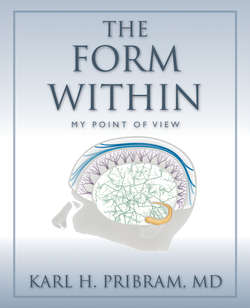Читать книгу The Form Within - Karl H Pribram - Страница 72
На сайте Литреса книга снята с продажи.
What’s the Difference?
ОглавлениеOur experience of the world is initially with objects, not images. The distinction between objects and images is fundamental to our understanding of how we perceive the world around us. We can look at objects from various perspectives to perceive various profiles, images, of the objects, but the imaging is secondary to the perception of objects. To perceive objects, either they or we make large-scale movements. Helmholtz made this distinction well over a century ago: he stated that objects are forms that remain unchanged despite movement; images are those perceptions that change with movement.
To demonstrate the distinction between objects and images, I conduct a simple demonstration. I have a volunteer, a student or a person attending a conference, close her eyes and extend her hand palm up. I then tap her palm with a key. I ask what she experiences. Ordinarily, the answer is “a poking on my palm.” Next I put the key into her palm, ask her to close her hand, moving her fingers. Again I ask what she is experiencing. Invariably, the answer is “a key.” Poking is imaged as happening “to me”; when the volunteer is moving her hand and fingers, she experiences an object “out there.”
In the auditory mode, the distinction between image and object is the basis of the difference between music and speech. We hear music; we speak speech. Music is centered on the ear; language is centered on the tongue (lingua in Latin). For instance, tones are images, profiles, which change as changes take place in the context within which they occur. Such tones, including vowel sounds, can be described as Gabor functions that embody what has come before and anticipate what is yet to come. By contrast, our perception of consonants is that they are like objects in that they remain stable over a wide range of changing contexts. Simulations that have been designed with the intent to produce gradual transitions between consonants such as “b” and “p” or “d” and “t” show that we do not perceive such gradations in sound. Technically, this phenomenon is known as “categorical perception.”
As higher-order constructions are composed, both music and language contain images and objects. Still, the distinction between being touched by music and actively forming speech is upheld because, at least in untrained subjects, musical images, tunes, tend to be processed primarily with the right hemisphere of the brain while ordinary language is more likely to be processed by the left hemisphere.
Another example of the distinction between our perception of images and of objects is provided by the sun’s radiant energy that warms and feeds us. When that radiant energy affects us, we “name” it light or heat, but it is not such when it occurs in outer space. It takes a considerable amount of active instrumentation by telescopes and interferometers to demonstrate that radiation exists as such. Physicists often use terms like “heat” or “light” to describe radiations of different wavelengths—a shortcut that can lead to confusion, not only for nonscientists, but, as well, even for the physicists who have used these labels. By contrast, in psychophysics we use the term “luminance” to describe radiation that is physically measured and therefore objective. We use the term “brightness” to describe and measure what we perceive. Radiant energy must fall on a receptor to be perceived as light or heat just as the oscillations of water that mediate its energy must strike the shore to become the breakers with the strength to topple us. In both cases— water and radiation—the patterns that make up the perceived objects—breakers and light/heat—are considerably different from the oscillating energies offshore or out in space.
